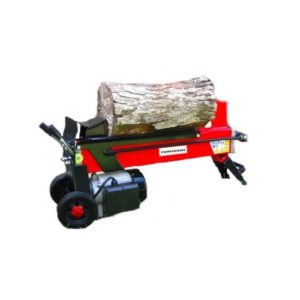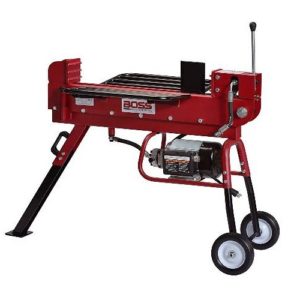
- Motor 3HP
- Log Cutting Capacity
- Distance: 15.7-inch

- Powerful 15A motor
- Use the log splitter
- Electric power

- Powerful 2HP motor
- 7 tons of splitting force
- Automatic ram return

- 18-second cycle time
- 15Amp induction motor
- Integrated stroke limiter

- 1500W power
- Waterproof Rate is IP 54
- Insulation class is class B

- Splitting force: 6 tons
- Cycle time: 22 sec
- Perfect for jobs

- Gas-like performance
- Durable hydraulic system
- Requires a 20Amp circuit

- Motor: 4HP
- 2900 Watts
- Increases torque by 45%

- 1,500 watt electric motor
- 4 tons of RAM splitting force
- NEW stronger packaging

- Splits firewood with less force
- Made of high-quality cast iron
- Virtually maintenance-free
Choose the Best Log Splitter
Customer’s Choice: the Best Rated Log Splitter
9 users answered this survey. Please help us improve this review!
As a professional gardener and owner of the best garden yard in the neighborhood (according to my wife), I don’t like to deal with the logs and big branches after cutting trees. That’s why I started to look for a special tool – log splitter – made to cut even the thickest branches left after a long gardening day.
Usually, I start with explaining the advantages of my gardening tools – but this time, I want to say about the serious drawback of any expert (not DYI) splitter for logs. On average, their price varies – $200 – $300. So, the choice must be very considered to avoid spending investments in vain. You ought to understand the pros and cons of every model before making a purchase. To save your time and money, my friends and I tested over 15 different log splitters and chose the top 10 models that are worth spending money.
Table of Contents
Factors to Consider When Buying Log Splitters: A Comparative Table
When purchasing a log splitter, there are several factors to consider that can impact its performance, efficiency, and usability. This comparative table presents a range of indicators to help you make an informed decision about the best log splitter for your needs.
| Indicator | Description | Impact on Performance |
|---|---|---|
| Tonnage | The amount of force the splitter exerts on the log. | A higher tonnage allows for easier splitting of larger and harder logs. |
| Cycle Time | The time it takes for the splitter to complete one splitting cycle. | A shorter cycle time can increase efficiency and speed up the splitting process. |
| Power Source | The type of power source used to operate the splitter (electric, gas, or manual). | Each power source has its own advantages and disadvantages, such as portability and maintenance requirements. |
| Log Capacity | The maximum length and diameter of logs that the splitter can handle. | A larger log capacity allows for greater versatility and efficiency in handling logs of various sizes. |
| Warranty | The length and terms of the manufacturer’s warranty. | A longer and more comprehensive warranty can provide greater peace of mind and protection for your investment. |
| Portability | The ease with which the splitter can be moved and transported. | A more portable splitter can be more versatile and easier to use in different locations. |
| Safety Features | The various safety features included with the splitter, such as guards and emergency stops. | More safety features can help reduce the risk of accidents and injuries during use. |
This comparative table provides an overview of some key factors to consider when purchasing a log splitter. By understanding and comparing these indicators, you can make an informed decision and choose a log splitter that best fits your needs and preferences.
FAQ
What types of log splitters are available?
There are three main types of log splitters available: electric log splitters, gas-powered log splitters, and manual log splitters. Electric log splitters are best for smaller logs, while gas-powered log splitters are more powerful and can handle larger logs. Manual log splitters are ideal for occasional use and smaller logs.
How much does a log splitter cost?
The cost of a log splitter depends on its type, size, and features. Manual log splitters can cost as little as $100, while electric log splitters can range from $200 to $1,000. Gas-powered log splitters are the most expensive, with prices ranging from $500 to $3,000 or more.
What should I look for when buying a log splitter?
When buying a log splitter, you should consider the type of wood you will be splitting, the size and weight of the logs, and the frequency of use. You should also look for features such as adjustable height, automatic ram return, and a fast cycle time.
How do I use a log splitter?
To use a log splitter, place a log on the splitter’s bed, adjust the height if necessary, and activate the splitter using the controls. The machine will apply force to the log, splitting it into smaller pieces. Always wear protective gear and follow the manufacturer’s instructions when using a log splitter.
Can a log splitter be used for commercial purposes?
Yes, log splitters can be used for commercial purposes, such as for firewood production. However, it is important to choose a log splitter that is designed for commercial use, with a high splitting force and durable components.
Can a log splitter be used instead of a pole saw?
No, a log splitter cannot be used instead of a pole saw. A log splitter is designed to split logs into smaller pieces by exerting force on the wood and separating it along its grain. A pole saw, on the other hand, is designed to cut through branches and limbs that are too large or high up for a regular chainsaw. It uses a long pole with a cutting blade at the end to reach higher branches and cut them off. Both tools are incredibly useful for different types of tasks when it comes to tree care, but they cannot be used interchangeably.
What is the difference between a horizontal and a vertical log splitter?
A horizontal log splitter is designed to split logs while they are placed horizontally on the machine’s bed. A vertical log splitter, on the other hand, is designed to split logs while they are placed vertically on the machine’s bed. Vertical log splitters are better suited for splitting larger and heavier logs, while horizontal log splitters are more suitable for smaller and lighter logs.
What is the splitting force of a log splitter?
The splitting force of a log splitter varies depending on the type and size of the machine. Manual log splitters typically have a splitting force of around 10 tons, while electric log splitters can range from 4 to 20 tons. Gas-powered log splitters have the highest splitting force, with some models capable of exerting up to 50 tons of force.
Can a log splitter be used to split other materials besides wood?
While log splitters are primarily designed for splitting wood, some models can also be used to split other materials such as bamboo, straw, and cornstalks. However, it is important to check the manufacturer’s specifications before attempting to split any other materials besides wood.
How do I maintain my log splitter?
To maintain your log splitter, you should regularly inspect and clean the machine, check the hydraulic fluid level, and replace any worn or damaged parts. You should also store the machine in a dry and secure location when not in use.
Is it safe to operate a log splitter?
While log splitters are generally safe to operate, it is important to follow the manufacturer’s instructions and wear proper protective gear, such as gloves and safety glasses. You should also ensure that the machine is on a stable and level surface before using it.
Quick look: PoleSawGuide’s pick of top 5 best log splitters for gardeners
- Powerhouse XM-380 – my overall decision based on such criteria as capacity, power of the motor and 15-inch distance;
- WEN 56207 – this instrument has the most powerful engine (15 A);
- Boss Industrial ES7T20 – its “splitting force” is amazing 7 tons, I couldn’t ignore such a distinctive feature;
- Southland SELS60 – can boast 18-second cycle time and a stroke limiter;
- Goplus 6 – is a very popular splitting appliance among my friends;
Surely, I have other 5 models if you didn’t find any good instrument for cutting logs. Or you may pick any other instrument in this category – just make sure that the asked cost is worth your investment. I’m very interested in your choice and experience with this quite new instrument in my collection of gardening instruments. By the way, be cautious while using one of the splitters at home – check the tutorial or hire a specialist!







I used to always pay someone to come out and split logs for me. However, I recently invested in a log splitter of my own and it was by far the right move! I use it to stash my firewood pile and break down large logs from around my property. We lose trees regularly in storms.
Having a log splitter is one of those things that takes up space in the garage; however, they are extremely useful when you need to use them. Avoid paying someone thousands and simply cut the log yourself. At least that’s my motto.
Hello, Colin! Thanks for sharing your experience.